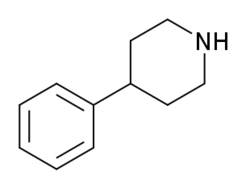
Phenylpiperidines are chemical compounds with a phenyl moiety directly attached to piperidine. Of particular interest are a variety of derivatives of 4-phenylpiperidine, which have pharmacological effects including morphine-like activity [1] or other central nervous system effects.
| Compound | N | 4-position | 3-position | 4'-position | Type of pharmacology |
|---|---|---|---|---|---|
| MPPP | Me | Ph | H | –OCOEt | Opioid analgesic |
| Prodine | Me | Ph | Me | –OCOEt | Opioid analgesic |
| PEPAP | CH2CH2Ph | Ph | H | –OCOMe | Opioid analgesic |
| Pethidine | Me | Ph | H | –CO2Et | Opioid analgesic with monoamine reuptake inhibitor activity |
| Budipine | t-Bu | Ph | H | Ph | Antiparkinsonian agent |
| Prodipine | iPr | Ph | H | Ph | Antiparkinsonian agent |
| Ketobemidone | Me | 3-HO–Ph | H | –COEt | Opioid analgesic and NMDA receptor antagonist |
| Paroxetine | H | 4-F–Ph | –CH2OAr [a] | H | Selective serotonin reuptake inhibitor |
| Enefexine | H | 4-Et–Ph | H | H | Antidepressant |
| Femoxetine | Me | Ph | –CH2O(4-MeOPh) | H | Selective serotonin reuptake inhibitor |
| CPCA | Me | 4-Cl–Ph | –CO2Me | H | Monoamine reuptake inhibitor |
Some of the butyrophenone antipsychotics, including aceperone, bromperidol, haloperidol, moperone, and trifluperidol, as well as the related diphenylbutylpiperidine antipsychotic penfluridol, are also 4-phenylpiperidine derivatives.
Certain other opioids, including alvimopan, loperamide, and diphenoxylate, are 4-phenylpiperidine derivatives as well.